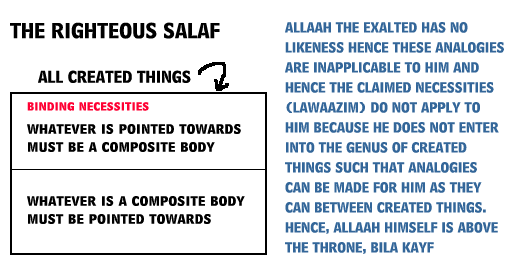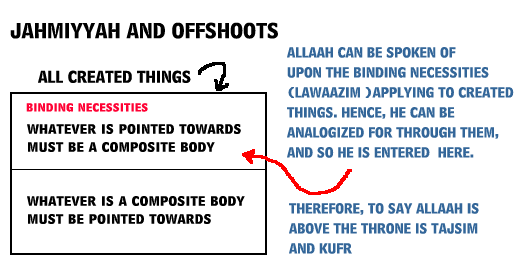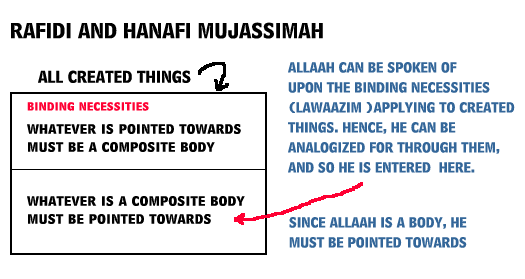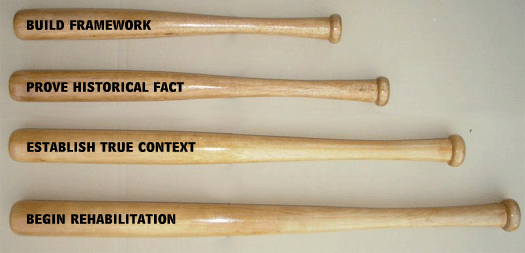| Monday, 19 January 2026 |
|
|
|
|
Never see Ash'ariyyah in the same light, ever again! Aristotle of Stageira, Philo of Alexandria, Augustine of Hippo, the Sabeans of Harraan, the Mu'tazilites of Basrah and Baghdad and the Jahmite Ash'ari Heretics of Today Claiming Orthodoxy. Read the first article, the second article, the third article, the fourth article, the fifth article.
| |
You are here:
Home  Articles
Articles
Introduction
The Sources of Information We are going to rely upon these books:
They are two books of Abu Mansur al-Baghdadi (d. 429H) an Ash'ari scholar, Usul al-Din and al-Farq bayn al-Firaq, and Abu al-Hasan al-Ash'ari's (d. 324H) Maqaalaat al-Islaamiyyeen. You can refer to the relevant entries in all these books under the Raafidah, and under the section on the Mushabbihah. Rather than provide full translations of entire passages, we are going to provide summary statements which will be exact translations of sentences in any case.
Understanding Definitions That Are Fabricated As we alluded to earlier in this series, in order to construct their theology, the Ahl al-Kalaam fabricated their own definitions for terms, with meanings that have no basis in the Qur'an or the language of the Arabs. Examples we gave [and some of which have been discussed in length in other articles (such as highlighting Naruiji's academic frauds)] include al-ahad, al-waahid, al-tarkib, al-jism. In order to truly fathom what was going on with all of these theological debates you have to appreciate that the Ahl al-Kalaam are operating upon polluted language, and you have to be aware of this when you are speaking to people who have been poisoned and intoxicated with it.
With respect to the term al-jism, it has two basic meanings. It refers to a) al-jasad, al-badan, the entity itself, whatever is being referred to, or b) the meaning of thickness, density pertaining to an entity. That is its meaning in the language of the Qur'an and of the Arabs. To the Ahl al-Kalaam (Mu'attilah or Mujassimah), they have their own devised definition for it, and their terms vary, some of them say, "whatever consists of two indivisible particles", and some say three, and some of the Mu'tazilah said six or eight (which means that extension would be in all three directions), and some of them said, "whatever occupies space, a space occupying entity", "whatever has the three spatial extensions (length, breadth, depth)", "whatever can be pointed at", "whatever is composite, composed (murakkab, mu'allaf)", that is one of their key ones. Also, whatever is said about it that it is here or there". And there is also "whatever is etablished by itself (al-qaa'imu bi nafsihi)", "whatever exists (mawjood)" (these last two are from the Karraamiyyah). We have around twenty or so definitions amongst them. What is important here, is that these people fabricated new meanings as a means to construct and validate their own theology [be they Mu'attilah or Mujassimah], which fundamentally is not based upon the principle of "Affirming for Allaah what He and His Messenger affirmed for Him," rather, it is:
Proving the universe is originated with a proof based upon the conceptual tools and language of astray nations from the past then making reason (aql) the judge of what Allaah ought to be described with to conform to that proof and then making distortion of the texts that do not agree with that version of theism (because they imply a'raad or hawaadith). So they all formulated their own definitions, and they have many differences amongst themselves and they refute each other in these definitions.
The Raafidee Ahl al-Kalaam Mujassimah, Mukayyifah, Mushabbihah Recall that the Raafidee Mujassimah were operating upon the proof of huduth al-ajsaam, like all the Mutakallimin, and they concluded Allaah is a body. And some of them inherited the deification of Ali (radiallaahu anhu) and others, and they mixed their Tajseem with tashbih and takyif. The three people in particular whose statements we will quote are from the kibaar (senior) of the Mutakallimin from the Raafidah (the two Hishams and Dawud al-Jawaaribee). Refer to al-Siyar of al-Dhahabi (10/544). All of these were in the mid to late second century hijrah, and they were involved in debate with the Mu'tazilah. Hisham bin al-Hakam al-Rafidee (d. 218H) He is from the senior ones amongst the Mutakallimin amongst the Raafidah and he used to debate and refute the Mu'tazilah and would write upon Tawhid upon ilm al-Kalaam. We will simply make summary translations of the essential points from our three sources above (and add comments). In general, these Raafidah considered Allaah to be upon the form of a man, in both his dhaat (essence) and his sifaat (attributes), and they added the language of tajsim and takyif due to their ilm al-Kalaam, as they were also debating the Mu'tazilah and were operating upon the language of al-ajsaam and al-a'raad. So this is what this vile Raafidee believed:
These types of descriptions follow on from his affirmation that Allaah is a jism following on from the proof of huduth al-ajsaam, and thus, his descriptions are of a type that are the opposite of what is found with the Mu'attilah.
So he is affirming types of attributes which Allaah is free of and have no basis in the revealed texts, and he is doing this upon the presumption that being a body, these attributes can be applicable to Him.
To the Raafidah, Allaah is already a jism, and hence they indulged in takyif in relation to His 'uluww over His Throne. It is for this reason, the early Kullaabi Ash'aris refuted these Raafidi Mujassimah as they refuted the Hanafi Mujassimah by saying "Allaah is above the Throne and is not a jism" (see this article) You should notice here that the Raafidi Mujassimah were not saying Allaah is a jism BECAUSE He is above the Throne. Rather, they already held He was a jism on account of the proof of al-ajsaam wal-a'raad. Thereafter, they simply made takyif of how He is above the Throne. This shows that being above the Throne has no connection to the issue of tajsim, not to Ibn Kullaab, not to al-Ash'ari and not to their early followers from Ahl al-Kalaam. But this was made binding by the Jahmiyyah and Mu'tazilah, that if Allah is above the Throne, He is jism (body), mahdud (confined, enclosed). And these Raafidah would come and oppose that baatil with their own baatil, that Allaah is a jism and created a space which He then occupied it, since He cannot be but a jism (body) which is nothing but a space-occupying entity (as defined by Ahl al-Kalam). As for affirming He is above the Throne, this was affirmed by all factions, the Salaf, the Kullaabiyyah, the Karraamiyyah, the early Ash'ariyyah, and likewise these Raafidah and all other factions. The only opposers were the Jahmiyyah and Mu'tazilah who were upon a Kalaami Bid'iyy negation. The Salaf were upon a Sunni, Athari affirmation (following what their Lord revealed). And the Mujassimah from Ahl al-Kalaam were upon a Kalaami, Bid'iyy affirmation (sharing in the language and terms with the rest of Ahl al-Kalaam).
Now, many of the statements you see coming from the Mu'attilah, such as the Ash'arites, are in refutation of this type of takyif, and the difference between the early Kullaabis, Ash'aris is that they refuted this language of takyif whilst affirming Allaah is above the Throne in agreement with the Salaf and in opposition to the Jahmiyyah, Mu'tazilah, whilst the later Ash'arites refuted this language of takyif whilst denying Allaah is above the Throne, in opposition to the Salaf and in agreement with the Jahmiyyah, Mu'tazilah.
More from the Raafidee Khabeeth:
A Very Important Issue The last sentence quoted above allows us to raise an extremely important issue. Notice here that both the Mu'attilah and Mujassimah are working off the same premises. Pay attention:
Notice the similarity in the underlying theoretical consideration. They are operating upon the same theoretical principles, and it is what they made the foundation of their respective theologies. You need to read the previous article to understand this, as we highlighted this matter in detail there. Basically, they are all operating upon the same false analogies for Allaah. From these false analogies is that whatever lawaazim (binding necessities) apply to created beings must also apply to Allaah. Thus, Allaah is included amongst the genus of created things as it pertains to these binding necessities and thus all are spoken in the same way. Hence, if it is said "above" about a created thing this necessitates it must be a composite body, then this same necessity must also be applicable to Allaah. Thus, Allaah has been entered into the genus of things about which this necessity is applicable. This is called qiyas al-shumool (analogy through inclusion), and this is baatil (false). Compare this with what the Salaf and early Kullabi Asharis said:
To help understand the differences between all these sayings, it is best explained with diagrams representing the angle each faction is coming from, first Ahl al-Sunnah:
Explanation: Ahl al-Sunnah do not permit false analogies for Allaah such that the lawaazim (binding necessities) applying to created things can be extended to Him by including Him with the genus of created things in relation to the applicability of these lawaazim (binding necessities). Thus if it is said that "anything said to be above must be a composed body" and "a composite body [occupying space] must be pointed towards," such rules only apply to created things. Allaah is other than created things, hence these rules and necessities cannot be extend to Him, since the reality of His essence is unknown. Therefore, dependence is only upon the language in what He revealed, since He is the most-knowledgeable of His own self and the most eloquent in conveying what it is He wants believed about Himself to the generality of mankind, and this has been conveyed through all revealed Books. Hence, Allaah [Himself] is above the seventh heaven, above the Throne, [just as He said], without asking how. This does not necessitate He is a composite body [upon the language of ahl al-kalaam], but we do not express such a negation as it is innovated language, since takyif in negation is erroneous just like takyif in affirmation. So Ahl al-Sunnah have wholesome pure milk, leading to sound constitution in body and mind with perfect agreement between authentic text and sound reason. As for the difference between the Salaf and Ibn Kullaab and al-Ash'ari (in the days he was a Kullaabi), then the Salaf made specific affirmation and general negation, whereas the early Kullabiyyah, Ash'ariyyah made specific affirmation and specific negation in this matter. Next, the Jahmiyyah and all their offshoots [Mu'tazilah, Later Ash'aris, Maturidis]:
Explanation: There is a theoretical consideration underlying the proof of huduth al-ajsaam which all these factions are operating upon (Jahmiyyah, Mu'tazilah, Later Ash'ariyyah, Maturidiyyah) which is that the lawaazim (binding necessities) applying to created things extend to Allaah, and Allaah is included amongst them from this perspective to allow the lawaazim to be applied, and the theology to be built. If this were not the case, then their entire theology would collapse.
So to continue, this is because their Tawhid - which consists of series of negations, negating Allaah to be a jism and the genus of incidental attributes or some of the incidental attributes [upon the differences between themselves] - their language of Tawhid is founded upon this theoretical premise, which is that Allah admits to these lawaazim being applicable to Him. Hence, if Allah is said to be "above" He must be a body (as is said of all created things). This leads to negation of Allaah being "above" (and the same with other attributes) in order to maintain their version of Tawhid. This "negative theology" is founded entirely upon the false analogy upon which they are operating. Without making that qiyas al-shumul for Allaah, this theology would not hold and could not exist. Hence, Allaah has to be entered within the genus of created things in terms of accepting the lawaazim (binding necessities) that apply to them, on the basis of which the negative theology arises. Take away that false analogy, and this theology has no foundation any more.
In conclusion, the Jahmiyyah and their offshoots have nothing but blood and puss. We can now look at the Raafidees (a word of warning, it stinks!)
Explanation: Now the Mujassimah have already argued Allaah can only be a body (jism), since there are only ajsaam (bodies) and their incidental attributes and Allaah cannot be an incidental attribute so He can only be a body. It is important to realize here that they started off with this conclusion. Thereafter, all of their language of tashbih and takyif follows on from this conclusion. This conclusion is from their rendering of the proof using the language of al-ajsaam and al-a'raad. Hence, if Allaah is a body (jism), He is of a given length, width, breadth, and so on, and He is of a particular size and so on, and He has color, taste, smell and so on, and He is a space-occupying entity (since the very definition of the jism with Ahl al-Kalaam is "a space-occupying entity"). Thus everything that is from the properties of a jism (i.e. as defined by Ahl al-Kalaam), can be said of Allaah. Like the Jahmiyyah and their offshoots, they made the lawaazim (binding necessitites) pertaining to created things admissible for Him and it is from this angle they say, "Since He is a body, He must be pointed towards." You need to understand the reality of where they are coming from and what premises they are operating upon, and what the real angle of their view is, and exactly what their tashbih and takyif springs and originates from. What these Mujassimah have with them is dung (we did warn you).
We continue with the vile sayings of the Raafidee:
We see here a mixture of things and even the approaches of the Mu'tazilah in making some attributes synonymous with the essence. You see these people had multiple influences, they were debating others too, which explain why they had such a messed up idea of what it is they are worshipping. Hisham bin Salim al-Jawaaleeqee This is another Raafidee, and there was also a sect called Hishaamiyyah after him. These are his views:
Dawud al-Jawaaribee Again, another Raafidee Mujassim:
Other Factions There are numerous other factions mentioned, from them, the Khattaabiyyah who ascribed divinity to Abu al-Khattaab al-Asadee. the Mugheeriyyah, followers of al-Mugheerah bin Sa'eed al-Ijlee who said his deity has limbs which are in the form of the letters of the alphabet! And the Bayaaniyyah, followers of Bayaan bin Sam'aan who said that his deity is in the form of a human, made of light. Discussion, Comments and Notes We see amongst the Raafidee Mujassimah a mixture of a) deification of humans, giving Allah a human form, and then b) the language of Kalaam as it relates to tajsim and c) something of the approaches of the Mu'attillah. These views came from the Mutakallimin amongst them and they had argued (just like the Hanafi Mujassimah we will be looking at next), through the language of al-ajsaam and al-a'raad (bodies and their incidental attributes) - as part of the proof of huduth al-ajsaam - that Allaah must be a jism (i.e. as defined by the Mutakallimin) - pay attention to this last bit - a jism as defined by the Mutakallimin. Hence, when they described Him, they described Him with relevant language, such as He has breadth, width, height, color, taste, smell and so on. This was the opposite of the language of the Mu'attilah (Allaah is not a jism, not an 'arad, not this, not that and so on). This is in addition to their gross tashbih. Further, in their Kalaam debates with the Mu'tazilah and others, they would also adopt some of the usool found with the Mu'attilah, such as making the attributes (most of them) to be synonymous with the essence, like they did with life, power, wish, hearing, seeing. So what we are seeing are in fact a mixture of influences, tashbih (between Allaah's dhaat and sifaat with those of the creation), and tajsim and some Kalaam which resembles that of the Mu'tazilah. Also a crucial thing you need to distinguish in your mind here as well is that just because the Raafidah affirm something that the Salaf (and the early Kullabi Ash'aris) affirmed [i.e. Allaah is above His Throne, Allaah has face, hands etc.], then this affirmation does not make it tashbih. Since tashbih is to say "Hand like my hand, face like my face, hearing like my seeing" and so on. The mere affirmation is not tasbhih, as is established from the Salaf like al-Tirmidhi, Nu'aym bin Hammad, Ishaq bin Raahooyah and the generality of the Imaams. The tashbih that the Salaf warned against was likening Allaah's attributes to those of the creation in their realities - which is what these Rafidah fell into, after they treated Allaah's dhaat to be like that of the humans and after they deified some amongst mankind. Further, they affirmed attributes Allah did not affirm for Himself and which are unique to humans, such as a heart, black hair, nose, mouth and so on. So there is tasbhih (in essence and attributes, even if those attributes have proof for them), and excess in ithbaat (with attributes that have no proof) and making tashbihh with respect to them too.
So with this :- And we are not finished yet - because the fourth piece in our toolset has not yet been unleashed, and we suggest that you keep a sound-recorder ready, because hearing those effeminate wails, screams and shouts from the makhaaneeth of the neo-Jahmiyyah operating upon centuries of calculated deception - when we start pounding their doubts - will be a moment written down in history, and you want to make sure you capture it for antiquties sake.
So with this, we say that as true historical fact, and the true context of things are slowly emerging and the deception is unravelling, we advise everyone to keep their eyes peeled for any pied-piper Jahmites who will try to flee the scence once the game is up. If you do see them and apprehend them, a small cash reward along with other goodies will be offered upon delivery to us, and we look forward to implementing justice upon them (by smashing their doubts).
Link to this article: Show: HTML Link • Full Link • Short Link
Related Articles:
You must be registered and logged in to comment. |


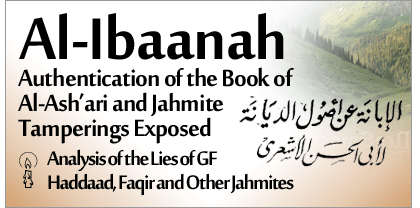
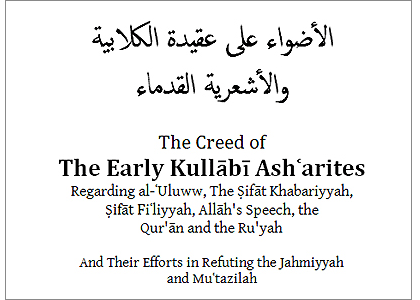


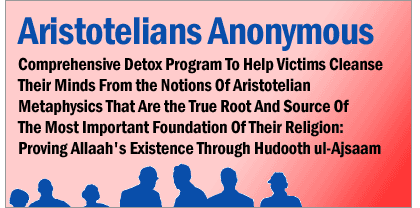
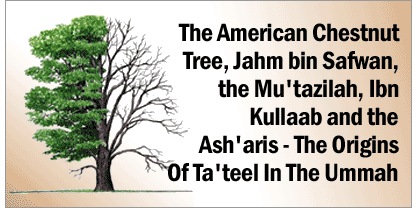
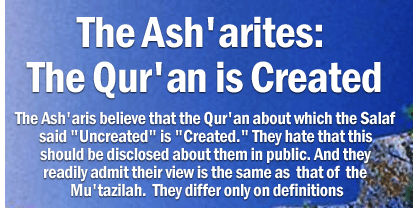
|
||||||||||||||||||||||||||||||||||||||||
 |
 | |
|
|

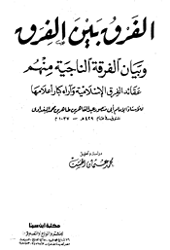
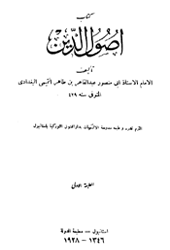
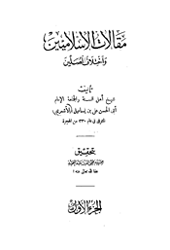
 Allah is a body with dimensions, he has height, breadth and depth (thickness), and all of these are equal (of equal height, breadth and depth).
Allah is a body with dimensions, he has height, breadth and depth (thickness), and all of these are equal (of equal height, breadth and depth). 